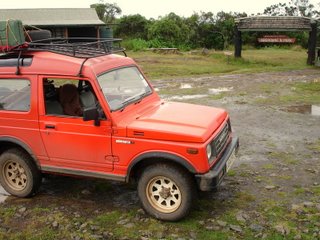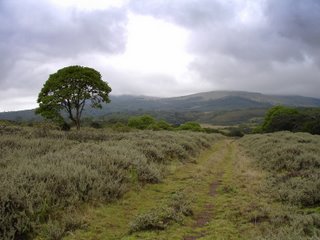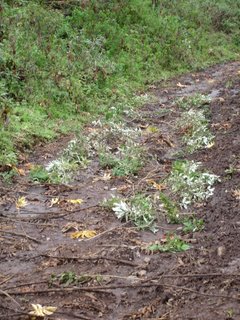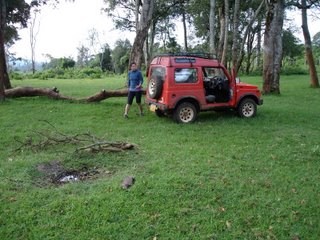
The Aberdares was an adventure unlike any that Jessica & I have been on before. There were highs and there were lows, and in the end we certainly felt strengthened -- and at the same time slightly exhausted -- by the experience. Here is an account of an adventure that we will no doubt recall for years to come, for better or for worse!
DAY 1 - The High Plateau
Aberdare National Park is made up of two distinct sections: moorland, peaks and forest atop a high plateau, and an outcrop of dense rainforest known as the Salient. The park intrigued us for this reason, but also because it would be a good place to find elephants, a species which Jessica still has yet to see in the wild. We decided to approach the park from the Rift Valley to the west, and enter the park via its western entrance. This route would take us straight into the high plateau.
We were to visit the park just at the end of
 the 'short rain' season here in Kenya. This was a slight concern because several of the roads in the Aberdares shut down when things get really wet due to the muddy conditions and mudslides. As we approached the western entrance there was a slight drizzle, but fortunately it wasn't the torrential downpours that we've been experiencing quite frequently these days. As we departed the Rift Valley we were soon able to make out the tall peaks that make up the Aberdare mountain range; four of the tallest of which range from 3500m to 4000m. Rising from foothills to the park gate we found that the road turned into a beautiful paved mountain pass. With each 100 meters we gained in altitude the temperature seemed to drop a degree or so. Soon we reached the gate to the park, paid our park fees to the warden, and also picked up the recommended park map which is only available at the park entrances.
the 'short rain' season here in Kenya. This was a slight concern because several of the roads in the Aberdares shut down when things get really wet due to the muddy conditions and mudslides. As we approached the western entrance there was a slight drizzle, but fortunately it wasn't the torrential downpours that we've been experiencing quite frequently these days. As we departed the Rift Valley we were soon able to make out the tall peaks that make up the Aberdare mountain range; four of the tallest of which range from 3500m to 4000m. Rising from foothills to the park gate we found that the road turned into a beautiful paved mountain pass. With each 100 meters we gained in altitude the temperature seemed to drop a degree or so. Soon we reached the gate to the park, paid our park fees to the warden, and also picked up the recommended park map which is only available at the park entrances.The temperature was colder than anything we've experienced in Kenya so far, and looking at my altimeter I noticed that we were way up at 3200 meters. I remembered being at this height at the basecamp on Mt. Ranier, and know first hand that it is certainly high enough to start feeling the effects of high altitude. The flora at this height was much different than anything we've previously encountered. We made our way to our camp first since it was around 4pm and we wanted to set things up in order to get a quick game drive in before sundown.
 After setting up camp we hit the road and found several buffalo, duikers (a type of antelope), and reedbuck. We decided that we had just enough time to visit the nearby Chania waterfalls. The falls were absolutely gorgeous, and the recent rains meant that they were at full-flow: an incredible sight.
After setting up camp we hit the road and found several buffalo, duikers (a type of antelope), and reedbuck. We decided that we had just enough time to visit the nearby Chania waterfalls. The falls were absolutely gorgeous, and the recent rains meant that they were at full-flow: an incredible sight.Just outside camp on our way back we stumbled upon another bonus: an encounter with a rare black (melanistic) serval cat. They are essentially like a small black panther, and seldom encountered in Kenya .
The wet conditions meant that making a fire was next to impossible, but nothing that a little gasoline couldn't rectify. We enjoyed shish-kabobs and hotdogs, and dined amongst several "eyes" watching around the campfire. The eyes belonged to buffalo and antelope (they light up with a greenish tint when illuminated with a flashlight), but also what we think were several hyenas (with a nice reddish-tint characteristic of predatory animals). This wasn't too much of a concern as long as the fire was going and we didn't stray to far from camp! That night we heard the barks of wild-dogs far off in the distance, and slept fairly well in our cozy little tent.
DAY 2 - Journey to the salient (or Decent from the Misty Mountains to the Shire)
We awoke to frigid conditions and quickly warmed ourselves with still-steaming coffee from our thermos at around 6:30am. We broke camp quite
 quickly as we were eager to start the day off and begin our quest for elephant. We returned to Chania falls for a quick breakfast (which was on the way) consisting of fruit salad, and also samosas warmed on the old engine block. Our goal for the day was to travel the 15 km or so it would take to get to the lowland area of the park known as the salient. It was there that we would have our greatest chance of finding elephants, in addition to other animals such as bongo antelope, wild bush pig, and rhinoceros. Our map that we had purchased at the entrance to the park, and which the warden had assured us was the best map available for the park, indicated that there were two roads leading to the salient. The southern route led to a large red mark on the map labeled "blockade" and then led outside of the park. The northern route was a bit longer, but ultimately led into the salient. Judging by the contour lines it appeared to be a beautiful mountain pass. When we got to the fork which separated the two we headed north and looked forward to avoiding having to exit the park and then re-entering it at another entry point, as the southern route would have required.
quickly as we were eager to start the day off and begin our quest for elephant. We returned to Chania falls for a quick breakfast (which was on the way) consisting of fruit salad, and also samosas warmed on the old engine block. Our goal for the day was to travel the 15 km or so it would take to get to the lowland area of the park known as the salient. It was there that we would have our greatest chance of finding elephants, in addition to other animals such as bongo antelope, wild bush pig, and rhinoceros. Our map that we had purchased at the entrance to the park, and which the warden had assured us was the best map available for the park, indicated that there were two roads leading to the salient. The southern route led to a large red mark on the map labeled "blockade" and then led outside of the park. The northern route was a bit longer, but ultimately led into the salient. Judging by the contour lines it appeared to be a beautiful mountain pass. When we got to the fork which separated the two we headed north and looked forward to avoiding having to exit the park and then re-entering it at another entry point, as the southern route would have required.The northern route proved to be gorgeous for the first 7 km. It didn't look like it had been used for a quite some time, but we hadn't seen a single other vehicle since we had entered the park so this
 did not come as any sort of surprise. We winded up grassy hills, traversed past alpine lakes, and descended through dense bamboo forests. Occasionally the lakes which were flooded would run into the road, but they were easily bypassed and we thought nothing of it. Just before making our decent into the salient, and with only about 5 km to go, the conditions became slightly more muddy. We were in a small valley which acted as a sink, collecting rainwater and turning dirt to thick mud.
did not come as any sort of surprise. We winded up grassy hills, traversed past alpine lakes, and descended through dense bamboo forests. Occasionally the lakes which were flooded would run into the road, but they were easily bypassed and we thought nothing of it. Just before making our decent into the salient, and with only about 5 km to go, the conditions became slightly more muddy. We were in a small valley which acted as a sink, collecting rainwater and turning dirt to thick mud."Momentum" I told Jessica "is key in these sorts of conditions!" as we blasted across large mud ponds, and pools of water almost 2 feet deep. Battlecat handled incredibly well, and we took comfort that if we did get stuck our faithful 4x4 was so small that it would only take one of us to push it out. As we rounded a corner I saw a small hill, about 20 metres long, that looked quite slightly more muddy than any we had encountered so far. I stomped the accelerator to the floor and pondered the best path to take up the hill. About half way up the tires started spinning, and our progress came to a stand still. I reversed back down the hill, got a good running start, and floored it once again. We made it about one foot higher than our first attempt. Several more attempts got us to roughly the same spot and we found ourselves having to decide if we should turn around and backtrack to the southern route or jump into the mud and muscle Battlecat up the final 10 meters.
We decided that we had come too far to turn tail and retreat. There were elephants to see, and some muddy hill wasn't going to interfere with our plans! How hard would it be to get up this slope of oozing 6-inch mud? Sure, we'd get a little dirty and sweaty. but surely it wouldn't take too long?
Oh, how wrong we were....
The muddy hill of doom
We started off with simple pushing. Unfortunately Jessica had never driven the 4x4 before (by her own decision!) and wasn't feeling comfortable maneuvering Battlecat out of the dirty mess. Even still we gave it a try with her driving, but the correct combination and
 timing of the parking break, clutch, and gas pedal wasn't happening. She decided it was best if she pushed. I wasn't comfortable with her doing all the hard work, but we both decided that it wouldn't take too long, and I was better at getting old Battlecat out of the mud. The elephants were waiting.
timing of the parking break, clutch, and gas pedal wasn't happening. She decided it was best if she pushed. I wasn't comfortable with her doing all the hard work, but we both decided that it wouldn't take too long, and I was better at getting old Battlecat out of the mud. The elephants were waiting.We quickly realized that we were getting nowhere simply pushing, rocking, and trying to get a bite by rotating the steering wheel to the two extremes. We would need some sort of traction. I abandoned my "tread lightly" mentality, pulled out my leatherman, and quickly proceeded to hack down all the surrounding folliage in order to create a path of traction. It was slow going. We tried using rocks. It was even slower going. We went back to sticks & leaves.
At this point we were committed. There was no way in hell we would give up after all this work, and we were going to get up this $%&*#@& hill if it was going to take us till sundown!
And so it went. We placed sticks on all sides of the tires, pushed with all our might, and the car would move another foot or so before getting stuck again. Using this technique we moved at a rate of 2 feet every 10 minutes. The top of the hill got closer and closer, and our resolve became greater and greater. Finally, just as the steep part of the slope started to decrease in grade I could feel the car gain extra horizontal traction, and Jessica's push allowed me to roar to the top of the hill. A scream of joy escaped my lips, and I hopped out at the top to greet Jessica as she made her way to the top of the hill. She was crying with joy, and we promised to ourselves that we would never attempt this part of the Aberdares during the rainy season again. It had taken us 2 1/2 hours to reach the top, and we were ready to continue on.
Back on the road
According to our super-accurate park-purchased map the last 5 km of the northern route we were taking led to the northern border of the park where there is an exit gate and a road that parallels the park b
 order before decending into the salient: our destination for the elephants. After the muddy hill debacle we were feeling pretty good about ourselves, and that we could get out of almost anything mother nature threw at us. Sure the day was pretty much spent (it was almost 4pm), but we had survived a difficult situation and we would have some great stories for years down the road. Our smiles faded as we approached the nothern gate only to discover that the road leading into the salient was closed (and had been for some time) and our only option was to exit the park at the gate, and then drive around to another entrance to the east.
order before decending into the salient: our destination for the elephants. After the muddy hill debacle we were feeling pretty good about ourselves, and that we could get out of almost anything mother nature threw at us. Sure the day was pretty much spent (it was almost 4pm), but we had survived a difficult situation and we would have some great stories for years down the road. Our smiles faded as we approached the nothern gate only to discover that the road leading into the salient was closed (and had been for some time) and our only option was to exit the park at the gate, and then drive around to another entrance to the east.We were not happy.
We drove to the gate to find that the park ranger guarding it was looking at us with quite dumbfounded expression. We stopped to say hi, and looking at our little 4x4 all he could say was "you came though in that?!". There was only one route we could have taken to get there, and we told the ranger that indeed it had been a tricky route, we had got stuck once, but that our little Battlecat was a strong car and we were quite proud of it. The ranger couldn't believe it. "You're the first car I've seen since a big Land Rover made it through about a month ago" he said.
The pride that we felt after finding out that we had just accomplished quite the off-road adventure -- even by Kenyan standards -- was slightly diminished by the fact that the route we'd have to take to get back inside the park was long and bumpy. We seriously contemplated giving up and just heading back to Nairobi, but we soon realized that we couldn't let the Aberdares defeat us! We still hadn't seen an elephant yet, and we refused to go home with our tail between our legs.
By the time we got to the next entrance to the park it was almost 6pm
 and the sun would soon go down. Our campsite wasn't too far away, and we barreled past huge wild bushpigs and numerous antelope as we raced the suns decent to the horizon. We arrived to find a much nicer campsite than where we had stayed the previous night. It was called 'Bongo Campsite' (after the rare 'Bongo' antelope) and is aptly named, for it is an antelope grazing pasture. It had nice short grass, and antelopes all over. We set up the tent and had a fire going in record time.
and the sun would soon go down. Our campsite wasn't too far away, and we barreled past huge wild bushpigs and numerous antelope as we raced the suns decent to the horizon. We arrived to find a much nicer campsite than where we had stayed the previous night. It was called 'Bongo Campsite' (after the rare 'Bongo' antelope) and is aptly named, for it is an antelope grazing pasture. It had nice short grass, and antelopes all over. We set up the tent and had a fire going in record time.There were no red-tinted eyes glowing at us around the campfire that night, just green ones indicating antelope and buffalo. Because of this, and also the nice soft ground, we slept very well.
DAY 3 - The Quest for Elephant Continues...
We awoke in the morning to find sunny skies and warm conditions: the exact opposite of the previous morning. We reasoned that since the conditions were in our favour, today would certainly
 be the day that we would find our elephants. To further lift our spirits, a black rhinoceros (rare in these parts compared with the white rhinoceros) trotted out the woods not 30 meters from us, turned the corner, and headed hack into some bushes a little further down the way as we packed the tent up. It was a good sign indeed.
be the day that we would find our elephants. To further lift our spirits, a black rhinoceros (rare in these parts compared with the white rhinoceros) trotted out the woods not 30 meters from us, turned the corner, and headed hack into some bushes a little further down the way as we packed the tent up. It was a good sign indeed.The roads in the salient criss-cross the park in an east-to-west fashion and we decided to make use of this feature by doing a 'sweep' of the park in order to maximize our chance of finding elephant. We would start at the southern end of the park where we were camping and criss-cross our way until we made it to the northern end. In this way we would transect the park about 6 times from east to west.
As mentioned before, the Aberdares is much different than the classical savannah parks of Kenya. It is quite hilly and densely vegetated.
 The first road we found ourselves on followed a beautiful ridge which paralleled a river. It was absolutely gorgeous and gave us a great vantage point to spot potential elephants. Mt Kenya broke through the clouds for a short period of time. We set off after breakfast feeling rejuvinated, inspired, and ready to spot some elephants.
The first road we found ourselves on followed a beautiful ridge which paralleled a river. It was absolutely gorgeous and gave us a great vantage point to spot potential elephants. Mt Kenya broke through the clouds for a short period of time. We set off after breakfast feeling rejuvinated, inspired, and ready to spot some elephants.As we worked our way from south to north we spotted numerous baboons, antelopes, buffalo, and bush pigs. We passed by gorgeous watering holes full of animals that we thought would be perfect drinking spots for elephants. But alas there were none to be seen.
We were also looking for other signs of elephant to assist our search. We had so far come across lots of elephant dropping, but unfortunately none of them were fresh. It wasn't until we reached the northernmost road in the park, the only road we hadn't checked yet, that we found fresh elephant tracks. The forest is dense in this part of the salient, but we followed these tracks with determination. They followed the road for some while, and then trailed into the forest. The forest was so thick we had no chance of spotting them, so we continued down the road in hopes that they might have emerged in order to cross the road again. Sure enough we picked up some more fresh tracks, but again they trailed into the forest, this time on the other side of the road. We cut the engine to attempt to hear any elephant sounds coming from the forest. Nothing.
Unfortunately it was getting to about midday by this point, and about time that we should be leaving in order to reach Nairobi at a good hour. Our quest for elephant was unsuccessful. We checked at the main gate with the rangers to inquire about elephant sightings so far that day. "They've been hiding in the forest recently" they told us. That would explain our difficulty in finding them.
All was not lost however. We had had a great adventure, seen numerous wildlife, and experienced a part of Kenya that is seldomly visited by western tourists. We felt stronger after our bout with the mud hill, and we had learned way more about safari in Africa than we could have ever expected. We accepted that it simply wasn't our time for spotting elephant, departed the gate, and headed south for Nairobi.


No comments:
Post a Comment